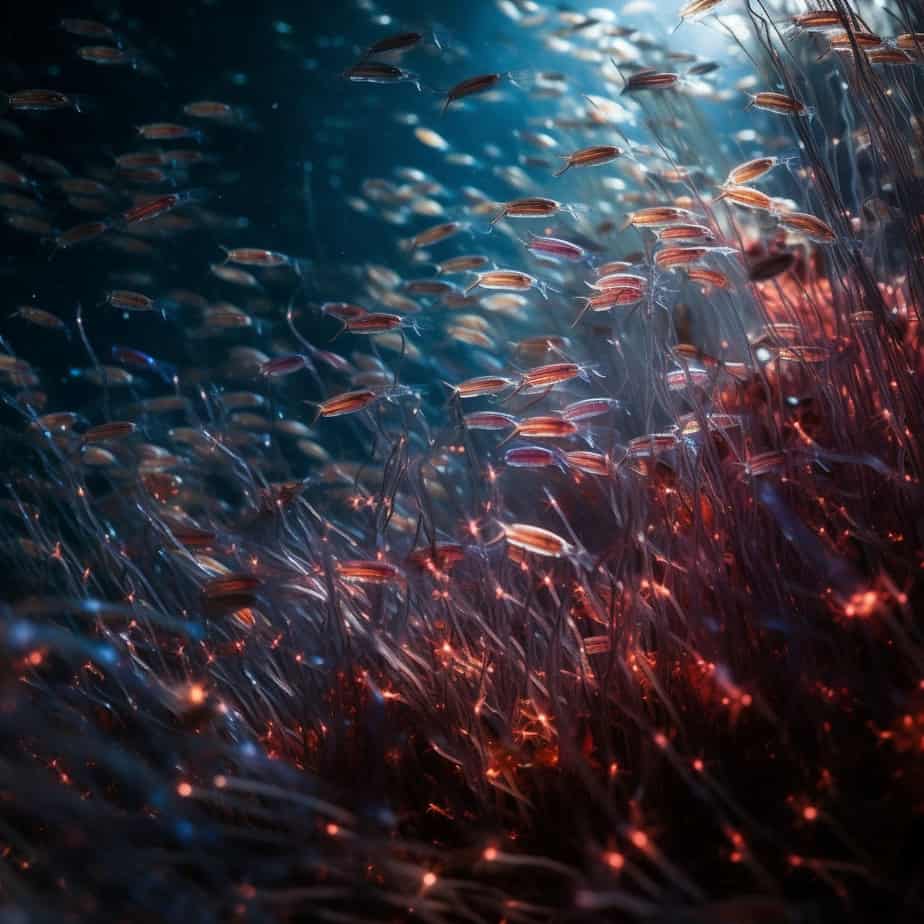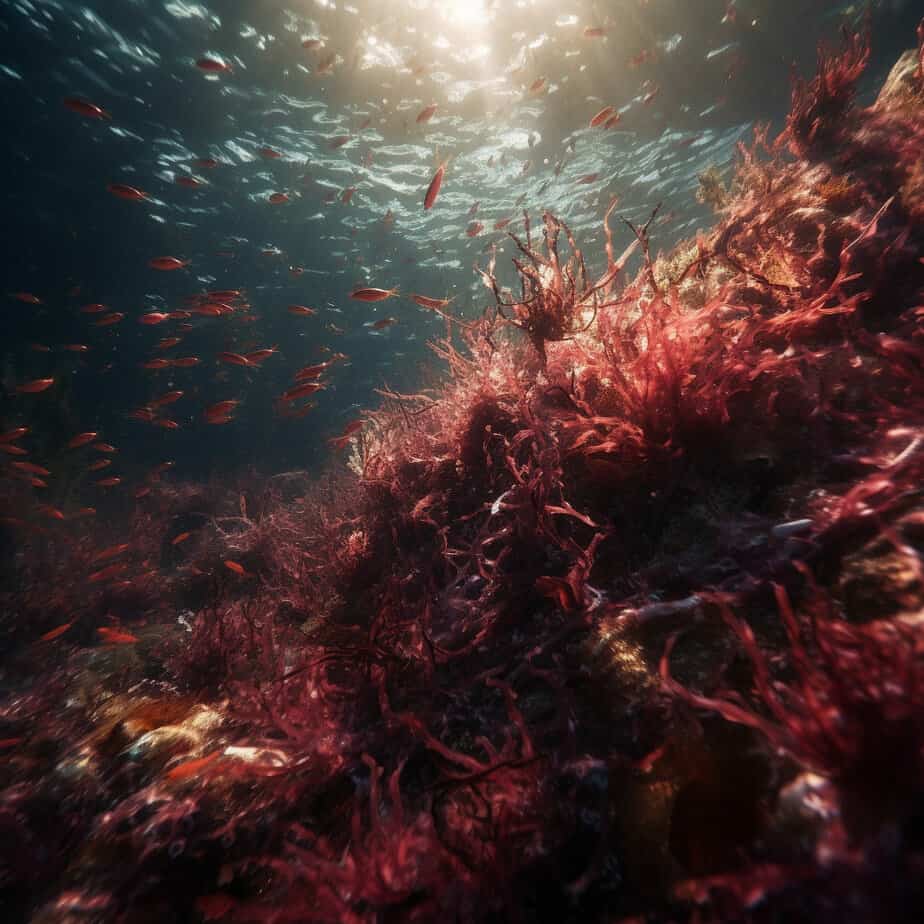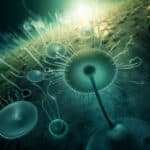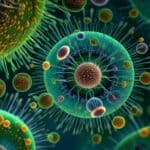Krill, small shrimp-like crustaceans found in oceans around the world, play a crucial role in marine ecosystems as a primary food source for many larger marine animals. These tiny creatures are known to consume a variety of food, including phytoplankton, which are microscopic plants that float near the ocean’s surface. Phytoplankton form the foundation of the marine food chain, producing oxygen and serving as a vital source of nutrients for countless organisms. In this article, we will explore the fascinating relationship between krill and phytoplankton, delving into the diet of krill and the importance of phytoplankton in their survival. So, let’s dive in and discover whether krill really do eat phytoplankton!
Key Takeaways
- Krill are small crustaceans that primarily feed on phytoplankton.
- Phytoplankton are microscopic plants that form the base of the marine food chain.
- Krill play a crucial role in transferring energy from phytoplankton to higher trophic levels in the ocean.
- The abundance of phytoplankton influences the growth and survival of krill populations.
- Understanding the relationship between krill and phytoplankton is important for studying marine ecosystems and their dynamics.
Understanding Krill: A Brief Overview

A. What are Krill?
Krill are small, shrimp-like crustaceans that play a vital role in the marine food chain and the overall health of the ocean ecosystem. These fascinating creatures are an essential part of the diet of many marine animals, including whales, seals, penguins, and fish. Despite their small size, krill form massive swarms that can contain millions of individuals, making them a significant component of the oceanic food web.
Krill belong to the order Euphausiacea and are found in all the world‘s oceans, from the frigid waters of the Antarctic to the temperate regions of the North Atlantic. They are known for their distinctive appearance, with a translucent body and large, compound eyes. Krill have a streamlined shape that allows them to move efficiently through the water, making them excellent swimmers.
B. Where do Krill Live in the Ocean?
Krill are highly adaptable and can be found in various habitats throughout the ocean. They are most abundant in cold, nutrient-rich waters, such as the Southern Ocean surrounding Antarctica. In these regions, krill populations can reach staggering numbers, forming massive swarms that stretch for miles.
Krill are primarily found in the upper layers of the ocean, where they feed on phytoplankton, microscopic algae that are the foundation of the marine food chain. Phytoplankton are photosynthetic organisms that convert sunlight and nutrients into energy, making them a crucial food source for many aquatic organisms.
Krill are considered zooplankton, which means they are drifting organisms that rely on ocean currents for movement. They have a unique feeding mechanism that allows them to filter tiny particles, including phytoplankton, from the water. Krill use their specialized appendages called thoracopods to create a current that brings water and food into their mouthparts, known as the feeding basket. They then filter out the phytoplankton and other small organisms, consuming them as their primary source of nutrition.
The abundance of phytoplankton in an area directly affects the krill population. When phytoplankton blooms occur, krill populations can experience rapid growth and reproduction. Conversely, a decline in phytoplankton availability can lead to a decrease in krill numbers, impacting the entire marine ecosystem.
In conclusion, krill are fascinating creatures that play a crucial role in the oceanic food web. They rely on phytoplankton for their survival and are an essential link between primary producers and higher trophic levels. Understanding the behavior, feeding habits, and habitat of krill is vital for studying marine biology and maintaining the delicate balance of the ocean ecosystem.
The Krill Diet: An In-depth Look
A. Do Krill Eat Phytoplankton?
Krill, the small crustaceans that inhabit the world‘s oceans, play a vital role in the marine food chain and the overall health of the ocean ecosystem. One of the primary components of the krill diet is phytoplankton, which are microscopic photosynthetic organisms that form the base of the oceanic food web.
Krill are known to consume various species of phytoplankton, including diatoms, dinoflagellates, and other types of microscopic algae. These tiny plants float near the ocean’s surface and provide an abundant source of nutrition for krill. Phytoplankton are rich in essential nutrients, such as carbohydrates, proteins, and lipids, which are crucial for the growth and survival of krill.
Krill have adapted to efficiently feed on phytoplankton by using their specialized feeding appendages called thoracic legs. These legs are equipped with fine hairs that allow krill to filter and capture phytoplankton from the surrounding water. As krill swim through the ocean, they continuously filter large volumes of water, extracting phytoplankton and other particles for consumption.
The consumption of phytoplankton by krill is not only important for their own nutrition but also for the overall health of the aquatic life in the ocean. By consuming phytoplankton, krill help to control the population of these microscopic plants, preventing excessive growth that could lead to harmful algal blooms. Additionally, the consumption of phytoplankton by krill transfers energy from the primary producers to higher trophic levels in the oceanic food web.
In conclusion, krill do indeed eat phytoplankton as a significant part of their diet. Their ability to consume and utilize these photosynthetic organisms is essential for their own survival and the balance of the marine ecosystem. The intricate relationship between krill and phytoplankton highlights the interconnectedness of life in the ocean and the delicate balance required for the sustenance of marine life.
Why Do Krill Eat Phytoplankton: The Science Behind

A. Nutritional Value of Phytoplankton
Phytoplankton, also known as microscopic algae, are the primary producers in the oceanic food web. These photosynthetic organisms play a crucial role in sustaining the marine ecosystem, and they serve as a vital food source for various aquatic life forms, including krill.
Krill, such as Antarctic krill, heavily rely on phytoplankton consumption for their nutrition and survival. Phytoplankton are rich in essential nutrients, including carbohydrates, proteins, lipids, vitamins, and minerals. These nutrients are vital for krill’s growth, reproduction, and overall health.
Krill feeding habits are primarily herbivorous, with phytoplankton being a staple part of their diet. They possess specialized mouthparts called thoracopods, which allow them to filter and consume large quantities of phytoplankton from the water column. This feeding mechanism enables krill to efficiently extract the nutrients they need from the microscopic algae.
B. The Role of Phytoplankton in Krill’s Life Cycle
Phytoplankton also play a significant role in the life cycle of krill. Krill reproduce by laying eggs, and these eggs require an abundant and nutritious food source to support their development. Phytoplankton provide the necessary sustenance for the growth and survival of krill larvae.
As krill larvae hatch from their eggs, they enter the water column as part of the zooplankton community. At this stage, they primarily feed on phytoplankton species, which are abundant in the ocean. The high nutritional value of phytoplankton ensures that the krill larvae receive the essential nutrients required for their rapid growth and development.
Phytoplankton consumption continues throughout the krill’s lifecycle, as they transition from larvae to juveniles and eventually mature adults. The availability of phytoplankton in their habitat directly influences the size and health of the krill population. Any changes in the phytoplankton abundance can have significant impacts on the krill population dynamics and the overall functioning of the marine ecosystem.
In conclusion, the consumption of phytoplankton is vital for the survival and well-being of krill. These microscopic algae provide the necessary nutrients for krill’s growth, reproduction, and overall health. Additionally, phytoplankton play a crucial role in the krill’s life cycle, providing sustenance for their larvae and supporting the growth of the entire population. Understanding the relationship between krill and phytoplankton is essential for marine biologists studying the intricate dynamics of the oceanic food web and the delicate balance of the ocean ecosystem.
The Krill-Phytoplankton-Zooplankton Triangle
A. The Interdependence of Krill, Phytoplankton, and Zooplankton
In the vast expanse of the ocean, a delicate balance exists between the various organisms that call it home. One such relationship is the interdependence between krill, phytoplankton, and zooplankton. These three components form what is known as the “Krill-Phytoplankton-Zooplankton Triangle,” a crucial aspect of the oceanic food web.
Phytoplankton, tiny photosynthetic organisms, play a vital role in this intricate ecosystem. They are responsible for producing approximately half of the world‘s oxygen and serve as the primary food source for many marine organisms. Krill, in particular, heavily rely on phytoplankton for their sustenance.
Krill, small shrimp-like creatures, are an essential link in the marine food chain. They are known for their voracious appetite and feed on various types of phytoplankton species. These microscopic algae provide krill with the necessary nutrients for their growth and survival.
B. How Krill’s Diet Affects the Ocean Ecosystem
The consumption of phytoplankton by krill has significant implications for the entire ocean ecosystem. As krill feed on these photosynthetic organisms, they not only obtain essential nutrients but also help regulate the phytoplankton population.
By consuming large quantities of phytoplankton, krill prevent excessive growth and maintain a balance within the ecosystem. This control is crucial because an overabundance of phytoplankton can lead to harmful algal blooms, which can have detrimental effects on other marine life.
Furthermore, the feeding habits of krill also impact the zooplankton population. Zooplankton, which includes various small animals, rely on phytoplankton for their nutrition. As krill consume phytoplankton, they indirectly affect the availability of food for zooplankton. This interplay between krill, phytoplankton, and zooplankton is vital for the overall health and stability of the oceanic food web.
In addition to their role in the marine food chain, krill also contribute to the carbon cycle. When krill consume phytoplankton, they incorporate the carbon from these organisms into their bodies. When krill die or are consumed by other marine creatures, this carbon is transferred to deeper ocean layers, effectively sequestering it from the atmosphere.
Understanding the intricate relationship between krill, phytoplankton, and zooplankton is crucial for marine biologists and researchers. By studying the feeding habits and behavior of krill, scientists can gain insights into the dynamics of the ocean ecosystem and its overall health.
In conclusion, krill play a vital role in the marine ecosystem by consuming phytoplankton and regulating their population. This interdependence between krill, phytoplankton, and zooplankton forms a delicate balance within the oceanic food web. By maintaining this equilibrium, these organisms ensure the health and stability of the ocean ecosystem, benefiting all forms of aquatic life.
The Importance of Krill in the Marine Food Chain

A. Why are Krill Important?
Krill, small shrimp-like crustaceans, play a crucial role in the marine food chain. Despite their small size, they have a significant impact on the overall health and balance of the ocean ecosystem. Let’s explore why krill are so important:
-
Foundation of the Food Chain: Krill serve as a vital link between primary producers, such as phytoplankton, and higher trophic levels in the oceanic food web. They form the primary diet for many marine organisms, including fish, whales, penguins, seals, and seabirds.
-
Phytoplankton Consumption: While krill primarily feed on phytoplankton, they also consume other microscopic algae and zooplankton. This diet makes them an essential component in maintaining the delicate balance of the marine ecosystem.
-
Nutrient Cycling: Krill play a crucial role in the recycling of nutrients in the ocean. When they consume phytoplankton, they absorb valuable nutrients, such as nitrogen and phosphorus, which are then released back into the water through their excretion. This process helps sustain the growth of phytoplankton and other photosynthetic organisms.
-
Population Control: Krill also help regulate the population of phytoplankton species. By consuming these microscopic plants, they prevent excessive blooms that can lead to harmful algal blooms (HABs) and disrupt the balance of the marine ecosystem.
B. Do Fish Eat Phytoplankton?
While some fish species do consume phytoplankton, their diet is not solely dependent on it. Fish have diverse feeding habits, and their diet varies depending on their species, size, and habitat. While some fish feed directly on phytoplankton, others are omnivorous or carnivorous, preying on smaller fish, zooplankton, or even other marine organisms.
It’s important to note that fish are not the primary consumers of phytoplankton in the marine food chain. Instead, they often rely on krill and other zooplankton as a source of food. Krill, being filter feeders, efficiently capture and consume large quantities of phytoplankton, making them an important intermediary between primary producers and higher trophic levels.
C. The Impact of Krill on Oceanic Biodiversity
The presence and abundance of krill in the ocean have a profound impact on the biodiversity of marine ecosystems. Here’s how krill contribute to the overall health and diversity of aquatic life:
-
Supporting Predators: Krill serve as a crucial food source for a wide range of marine predators, including whales, seals, penguins, and seabirds. These predators rely on krill as a primary food source during certain seasons or throughout their lifecycle.
-
Species Interactions: The availability of krill influences the behavior and distribution of various marine species. For example, the migration patterns of whales are often linked to the movement of krill populations. Changes in krill abundance can have cascading effects on the entire oceanic food web.
-
Energy Transfer: Krill efficiently convert the energy stored in phytoplankton into a form that can be utilized by higher trophic levels. This energy transfer is crucial for sustaining the growth and reproduction of larger marine organisms, ensuring the stability and productivity of the ecosystem.
In conclusion, krill play a vital role in the marine food chain and the overall health of the ocean ecosystem. Their consumption of phytoplankton, along with their position as a primary food source for numerous marine predators, highlights their importance in maintaining the delicate balance of aquatic life. Understanding the behavior, habitat, and nutrition of krill is essential for studying marine biology and preserving the biodiversity of our oceans.
Debunking Misconceptions: Is Krill Phytoplankton?
When it comes to the intricate workings of the ocean ecosystem, there are often misconceptions that can cloud our understanding. One such misconception revolves around the diet of krill, a vital component of the marine food chain. Many people wonder, “Do krill eat phytoplankton?” Let’s delve into this topic and debunk any misunderstandings.
To understand the relationship between krill and phytoplankton, it’s essential to first grasp the role of phytoplankton in the oceanic food web. Phytoplankton are microscopic algae that play a crucial role in sustaining aquatic life. Through photosynthesis, they convert sunlight and nutrients into organic matter, serving as the primary producers of the ocean. These tiny organisms are the foundation of the marine food chain, providing sustenance for a wide range of organisms, including krill.
Krill, on the other hand, are small, shrimp-like crustaceans that inhabit the world‘s oceans. They are an essential link in the marine food web, serving as a vital food source for many larger marine creatures, such as whales, seals, and penguins. While krill do consume a variety of organisms, including zooplankton, they also rely heavily on phytoplankton as a significant part of their diet.
Krill feeding habits are diverse and depend on various factors, including the availability of food sources and their own nutritional requirements. They have specialized feeding appendages called thoracopods, which they use to filter and consume their food. These appendages allow them to capture and ingest phytoplankton, among other small organisms, from the water column.
It’s important to note that not all phytoplankton species are consumed by krill. They have preferences for certain types of phytoplankton, which can vary depending on their nutritional needs and the specific phytoplankton species present in their habitat. This selective feeding behavior helps maintain a balance in the krill population and ensures the survival of different phytoplankton species.
Krill’s reliance on phytoplankton for nutrition is not only crucial for their own survival but also for the overall health of the ocean ecosystem. By consuming phytoplankton, krill help regulate the abundance and distribution of these photosynthetic organisms, preventing excessive blooms that can disrupt the delicate balance of the marine environment.
In conclusion, krill do eat phytoplankton as part of their diet. While they also consume other organisms, phytoplankton play a significant role in their nutrition and overall survival. Understanding the interplay between krill and phytoplankton is essential for comprehending the intricate dynamics of the oceanic food web and the vital role these organisms play in sustaining marine life. Conclusion
In conclusion, krill are small, shrimp-like crustaceans that play a vital role in the marine food chain. They are filter feeders, meaning they consume tiny particles suspended in the water. Phytoplankton, which are microscopic plants, form the primary source of food for krill. These tiny organisms are rich in nutrients and provide krill with the energy they need to survive and reproduce. Krill feed on phytoplankton by using their specialized feeding appendages called thoracopods to filter out the particles from the water. The consumption of phytoplankton by krill not only sustains their own population but also has a significant impact on the entire marine ecosystem. As krill are a crucial food source for many marine animals, including whales, penguins, and seals, any changes in their population or feeding habits can have far-reaching consequences. Therefore, understanding the relationship between krill and phytoplankton is essential for the conservation and management of these delicate ecosystems.
Frequently Asked Questions
Q1: Do krill eat zooplankton?
Yes, krill do eat zooplankton. It forms a significant part of their diet. Krill are known to be omnivorous and feed on a variety of food sources, with zooplankton being one of them.
Q2: Can krill eat seaweed?
No, krill do not typically eat seaweed. Their primary food source is phytoplankton, microscopic algae that float in the ocean’s upper layers. Seaweed is too large and complex for krill to consume.
Q3: Why do krill eat phytoplankton?
Krill eat phytoplankton because it is a readily available food source in their oceanic habitat. Phytoplankton are photosynthetic organisms that provide krill with essential nutrients for survival.
Q4: Do krill eat phytoplankton?
Yes, krill do eat phytoplankton. It forms the basis of their diet and is crucial for their nutrition and survival in the Antarctic ecosystem.
Q5: Is krill phytoplankton?
No, krill are not phytoplankton. Krill are small crustaceans, while phytoplankton are microscopic photosynthetic organisms. Krill are consumers in the marine food chain, whereas phytoplankton are primary producers.
Q6: What do krill eat in the ocean?
In the ocean, krill primarily eat phytoplankton and zooplankton. Their diet can vary based on availability and includes a variety of microscopic algae and other small organisms.
Q7: Does krill eat plankton?
Yes, krill do eat plankton, including both phytoplankton (plant plankton) and zooplankton (animal plankton). This forms the basis of their diet and provides them with essential nutrients.
Q8: Does krill eat zooplankton?
Yes, krill do eat zooplankton. They are omnivorous and can consume a variety of organisms, with zooplankton being a significant part of their diet.
Q9: Does krill eat seaweed?
No, krill do not typically eat seaweed. They primarily consume phytoplankton and zooplankton, which are more suited to their size and digestive capabilities.
Q10: Do fish eat phytoplankton?
Some species of fish do eat phytoplankton, but many fish, especially larger ones, are carnivorous and eat smaller fish or zooplankton. Phytoplankton is more commonly consumed by smaller aquatic organisms like krill.




